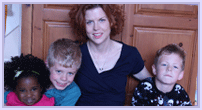Book Review: “Why Are All the Black Kids Sitting Together in the Cafeteria?”
 “Why Are All The Black Kids Sitting Together in the Cafeteria?”: A Psychologist Explains the Development of Racial Identity by Beverly Daniel Tatum
“Why Are All The Black Kids Sitting Together in the Cafeteria?”: A Psychologist Explains the Development of Racial Identity by Beverly Daniel Tatum
My rating: 5 of 5 stars
Publisher’s Description:
Walk into any racially mixed high school and you will see black youth seated together in the cafeteria. Of course, it’s not just the black kids sitting together-the white, Latino, Asian Pacific, and, in some regions, American Indian youth are clustered in their own groups, too. The same phenomenon can be observed in college dining halls, faculty lounges, and corporate cafeterias. What is going on here? Is this self-segregation a problem we should try to fix, or a coping strategy we should support? How can we get past our reluctance to talk about racial issues to even discuss it? And what about all the other questions we and our children have about race? Beverly Daniel Tatum, a renowned authority on the psychology of racism, asserts that we do not know how to talk about our racial differences: Whites are afraid of using the wrong words and being perceived as “racist” while parents of color are afraid of exposing their children to painful racial realities too soon. Using real-life examples and the latest research, Tatum presents strong evidence that straight talk about our racial identities-whatever they may be-is essential if we are serious about facilitating communication across racial and ethnic divides. We have waited far too long to begin our conversations about race. This remarkable book, infused with great wisdom and humanity, has already helped hundreds of thousands of readers figure out where to start.
This is an excellent book on racism and racial identity. It’s very readable and would a great first book for someone just learning about the concepts of white privilege and institutional racism.
The author walks the reader through the development of one’s racial identity (both black and white) from pre-school through adulthood, with every point backed up with research. I think her section on “white identity” will be truly eye-opening to a lot of white people who read it. I’ve taken quite a few workshops related to white privilege and racism and the author did a nice job of compiling everything I’ve learned all into one book. She writes objectively, without anger and without trying to make the white reader feel guilty about being white.
Although most of the book deals with black people and white people, there is a chapter that deals with other people of color. However, this book was written pre-9/11 – I think the section on people of Middle Eastern descent would have been different and perhaps longer if she had written it post-9/11.
I wish I could make this book required reading for just about everyone. I originally bought it because I thought it would help me in raising my daughter (who is African American) but actually this book has valuable information that I can use with ALL of my kids to help them grow up to be conscientious citizens of the world.
Buy this book at:
Amazon Powell’s Books





Pingback: Chaos Is A Friend of Mine » Blog Archive » Page to Screen: Imitation of Life (1934)()